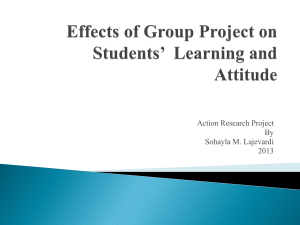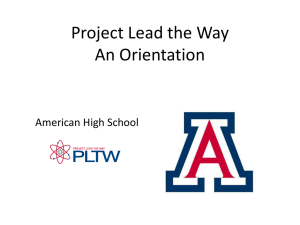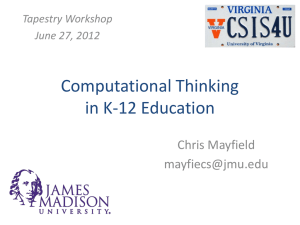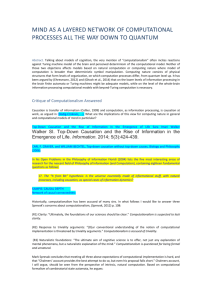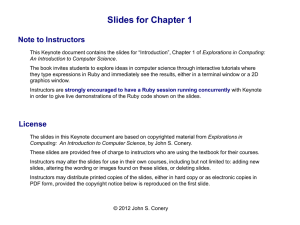Addressing the Problem of Basic Computational Abilities in a
advertisement
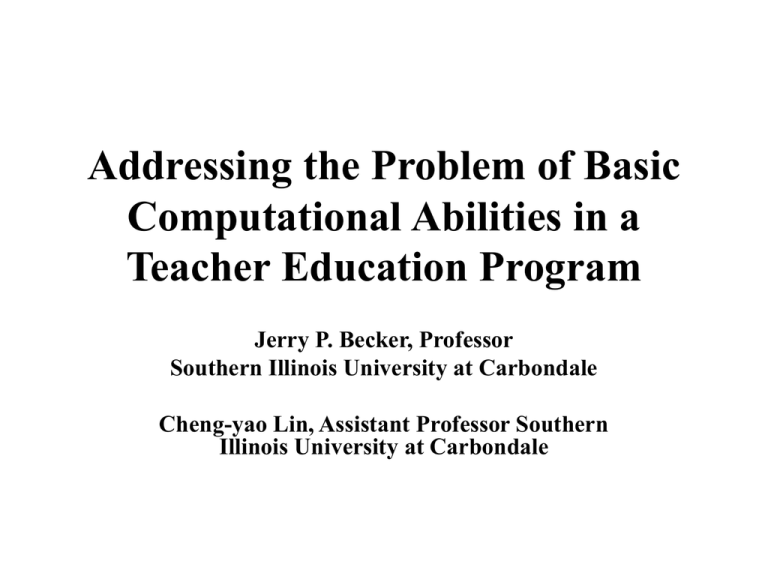
Addressing the Problem of Basic Computational Abilities in a Teacher Education Program Jerry P. Becker, Professor Southern Illinois University at Carbondale Cheng-yao Lin, Assistant Professor Southern Illinois University at Carbondale MATHEMATICS COURSES IN OUR TEACHER EDUCATION PROGRAM Until recently, we had three courses required of our elementary education majors: Math 114 (mathematics) -- taught in the Department of Mathematics Math 314 (mathematics) -- taught in the Department of Mathematics C&I 315 -- (“Methods”) -- taught in the Department of Curriculum & Instruction A few years ago these three courses were replaced by four (4) new courses that are crosslisted in the two departments, all required of elementary education majors: C&I/Math 120 -- Number systems ; A little probability and statistics ; Pedagogy C&I/Math 220 -- Number systems ; A little geometry, a little statistics ; Pedagogy C&I/Math 321 -- Geometry Pedagogy C&I/Math 322 -- Algebra Pedagogy MAIN STRANDS IN THE ELEMENTARY SCHOOL MATHEMATICS CURRICULUM . Number and number operations [This strand requires the lion’s share of a teacher’s time] . Geometry . Algebra . Measurement . Probability . Statistics 83 x 45 ADDITION FACTS 0 +1 3 +2 5 +8 2 +4 0 +7 9 +6 7 +9 4 +2 3 +4 1 +1 2 +0 8 +3 1 +6 9 +7 8 +9 4 +0 3 +3 5 +2 9 +2 0 +6 1 +2 4 +1 9 +3 0 +0 7 +3 6 +8 9 +5 2 +5 1 +9 8 +7 6 +0 8 +4 5 +4 2 +8 3 +0 1 +7 7 +2 6 +6 7 +8 4 +3 0 +9 1 +4 8 +2 6 +3 5 +5 7 +6 9 +9 4 +8 6 +9 3 +8 9 +1 0 +2 7 +5 4 +6 3 +7 1 +0 5 +6 8 +8 9 +0 3 +5 1 +8 0 +4 9 +8 3 +6 2 +2 7 +4 6 +2 7 +7 8 +1 4 +7 1 +3 0 +5 1 +5 9 +4 7 +0 8 +6 8 +0 6 +1 2 +7 2 +3 6 +7 5 +1 6 +5 0 +8 7 +1 5 +9 4 +4 2 +1 8 +5 6 +4 5 +7 0 +3 5 +0 3 +9 4 +5 5 +3 4 +9 3 +1 2 +6 2 +9 MULTIPLICATION FACTS 0 x1 3 x2 5 x8 2 x4 0 x7 9 x6 7 x9 4 x2 3 x4 1 x1 2 x0 8 x3 1 x6 9 x7 8 x9 4 x0 3 x3 5 x2 9 x2 0 x6 1 x2 4 x1 9 x3 0 x0 7 x3 6 x8 9 x5 2 x5 1 x9 8 x7 6 x0 8 x4 5 x4 2 x8 3 x0 1 x7 7 x2 6 x6 7 x8 4 x3 0 x9 1 x4 8 x2 6 x3 5 x5 7 x6 9 x9 4 x8 6 x9 3 x8 9 x1 0 x2 7 x5 4 x6 3 x7 1 x0 5 x6 8 x8 9 x0 3 x5 1 x8 0 x4 9 x8 3 x6 2 x2 7 x4 6 x2 7 x7 8 x1 4 x7 1 x3 0 x5 1 x5 9 x4 7 x0 8 x6 8 x0 6 x1 2 x7 2 x3 6 x7 5 x1 6 x5 0 x8 7 x1 5 x9 4 x4 2 x1 8 x5 6 x4 5 x7 0 x3 5 x0 3 x9 4 x5 5 x3 4 x9 3 x1 2 x6 2 x9 SOME EXAMPLES OF BASIC ADDITION AND MULTIPLICATION FACTS STUDENTS GOT WRONG ADDITION: 9 + 8 8 +7 7 +6 9 +6 Others [Number of mistakes ranged from 0 to 12 ] MULTIPLICTION: 8 x6 9 x9 8 x 7 6 x7 5 x8 Others [Number of mistakes ranged from 0 to 33 ] 50 -ITEM COMPUTATION TEST POINTS 50 49 48 47 46 45 44 43 42 41 40 39 38 37 36 35 34 33 32 31 30 29 28 27 26 25 24 23 22 21 20 19 18 17 16 15 14 13 12 11 10 9 8 7 6 5 4 SECTION 1 × × × × SECTION 2 × × × × × × × × × × × × × × × × × × × × × × × × × × × × × × × × × × × × × × × × × × × × × Some Surprising Results PROBLEM 1. Why are students who seek to enter our Teacher Education Program so weak in computational skills and understanding? [See handout: Question] 2. What can be done about it? What are we doing about it in our Teacher Education Program at Southern Illinois University Carbondale? We are using the so-called Japanese Open Approach to teaching, based on research done by Japanese mathematics educators. . Appeal to students’ natural ways of thinking . Look at problems in several/many different ways [many ways to get a correct answer] . Compare and contrast students’ different ways of solving or finding answers from a mathematical point of view . Introduce simpler problems and solve before more complex problems . Use representations in solving problems – e.g., use the number line or other models of the number systems [some from the Internet] . Provide practice in finding answers by using problems that require mathematical thinking/problem solving, but require students to do computation to get solutions WHAT WE DID TO IMPROVE STUDENTS’ COMPUTATIONAL UNDERSTANDINGS AND SKILLS After the pre-tests [addition facts, multiplication facts, 50-item computational skills test], we did the following: . All students were required to write down in their Notebooks every basic fact and computational problem they had incorrect; thus, they explicitly knew what they had to learn or re-learn and practice. . Regarding the basic facts, we simply told the students we were not going to re-teach them, but they had to learn them on their own, with our assistance outside class if necessary; we referred students to websites where they could get help and practice . Regarding the 50-item computational pre-test, we worked every problem in detail, requiring students to write full and complete notes in their Notebooks for study outside class . For each problem, we solved it in different ways, following the ideas offered by the students – then we discussed the different ways -- comparing and contrasting them mathematically (following Japanese research on this) . We handed out a set of 15 practice worksheets [in computation] covering all the aspects of computation on the pre-test: All students were required to complete the worksheets and turn them in just before the post-test –- showing their work [paper and pencil - no technology] . We gave short quizzes on the computation problems similar to those on the pre-test. . We administered the post-test after about three (3) weeks – it was scored and counted as an hourly test towards the final grade in the course. [We did not count the pre-test, but the students did not know that in the beginning.] . Between the post-test and the post-post test (final test), we did no further re-teaching of the basic arithmetic on the pre-test and post-test; rather, following the work of Japanese and German mathematics educators, we posed a number of problems for students that had the following characteristics: . there was an easy rule to get the students “into” the problem . solving the problems engaged students in genuine mathematical thinking . solving the problems required students to get practice in their computational skills [i.e., computational practice was embedded into problem solving, not isolated from it] . the problems were related to higher level mathematics – middle school, high school and college . We administered a third form of the computational skills test as part of the 2-hour final test in the course contry SIUC USA 3.00 Taiwan 2.00 Korea 1.00 10.00 10 20.00 20 30.00 30 computa tion scores 40.00 40 50.00 50 SIUC Taiwan Korea CONCLUSION The boxplots show that through re-teaching we can significantly raise our pre-service students computational scores over just a 3-week period. [In fact, we raised them to between the high achieving levels for Taiwanese and Korean beginning pre-service elementary teachers (comparable students).] Then, as seen in the boxplots, the students retained the knowledge and skills over the rest of the course up to and including the final test, but with no further re-teaching. Rather, the further computational practice in the course was embedded in problem solving after the post-test, that seems like a very good approach. While we continue working to improve and maintain our pre-service teachers' computational skills and understandings in subsequent courses, we will next tackle improvement of their knowledge and skills in geometry, that may very well be worse than their arithmetic (computational skills) ... such is the nature of our pre-service teacher preparation these days! We think we can view these results as real improvement for students in our teacher education program and we now have evidence that we can help students to re-learn arithmetic and maintain this knowledge and skills throughout the course and into and during the next course. [Further, we believe we are retaining students in our Teacher Education program who otherwise would likely drop out of the program. If we can do this throughout the 4-course sequence [that we will determine] including geometry and algebra, right up to Student Teaching, we feel we will have accomplished quite a lot in terms of improving our teacher education program in mathematics. QUESTION: Why are students' computational abilities so weak, especially when they arrive at a college/university and, especially, when they arrive in our courses in pre-service teacher education at SIUC? POSSIBLE REASONS: . Students are not taught computation in school. We really don't know how much truth there is to this. Our guess is that teachers perceive that they are teaching computation. . Students do not practice computation as kids used to while in school. Probably true. But we also hear "horror stories" of kids who have to do literally hundreds of computation worksheets at the expense of conceptual understanding. We don't think mere drill is the answer. . Students are taught computation only by rote (the rules) and do not remember them. Probably true. We fear that their teachers learned computation by rote, and though they may now remember the rules correctly (or maybe not), they do not understand why the rules work so they cannot help their students understand the processes nor develop their own methods. They cannot even judge whether a student's own non-traditional method is a valid one. . Students use calculators that distract them from hand/mental computation. Well, we have SEEN college students reach for a calculator to calculate 300 x 0 (really!) and 6.90 divided by 3. We would hazard a guess that they have not done any hand/mental computations for a VERY long time. . Students do not do homework as students used to. Probably true. It should be easy to document this through interviews or surveys with long-term teachers. . Teachers do not expect students to do homework as they used to, of which computation is a part. Probably true, though we hear reports of very young children packing very heavy books home in their book bags, the implication being that it never used to be this way. . Students are not supervised regarding their school work, neither in school nor at home, as they used to be. Probably true. The rapid rise in the number of single-parent households probably relates to this. The present economy driving one or both parents to work a second or third job just to cover expenses probably also relates to this. . Parents are not involved in their children's schooling as they used to be. Possibly -- see above. It is not clear that parents these days value education as much as we would like. . Students these days are digital natives, that is, they are more "into” digital devices than used to be the case: cell phones, iphones, ipods, sophisticated wristwatches, blackberries, texting, etc. and devote a lot of time to it, leaving little time for school learning. Maybe students were always into something. But a disciplined home and school environment kept their focus on learning during school. There is no need for digital devices to be taking time away from school learning. (In fact, on the rare occasions when we find a student texting in our classes, we simply hold out our hands for the device and put it on the front desk until class is over.) . Kids are more interested in electronic devices they can play with than they used to be, in competition with learning computation in school. Maybe. That's a reality we face. We need to find creative ways to turn that interest to the good. . Kids' brains are wired differently now and it is not consistent with how or what they are taught in school. Maybe. We don't know - also, how would one measure this? We don't know how to separate environmental and social changes (lower expectations? less emphasis on "self-discipline"? lots more time in front of a TV or computer screen? less respect for education?) from actual changes in brain function. From what little we have read about the brain in the literature, we do think it is possible that young brains are now wired differently, maybe not from birth, but as a result of their experiences in the pre-school and early school years; but then, again, maybe from birth? . Students spend a great deal of time watching TV that is in competition with doing work connected to school. Maybe. Parents COULD control this -- which brings us back to issues listed above. . Most students probably don't think they should spend the time on it since it can be done so easily for them with technology ... calculators, automatic cash registers ... etc. Why should they memorize in school learning in order to do that? So use lots of experiences that give them a healthy distrust for technology! We don't think it makes sense to pretend the technology does not exist, any more than we would seriously pretend that cars were never invented. The challenge is to make technology an ally in the learning process. . There is so much emphasis on standardized tests in schools that teachers just teach to the tests and don't provide practice on the basic facts like they once did, nor emphasize learning and understanding computational procedures. Is it true that standardized tests DON'T test basic facts? We have never thought about that. We do know that teachers feel pressured to teach what will be covered on the test and we suspect that this process sacrifices higher level thinking in favor of tricks for getting a correct answer. If it led to teaching efficient algorithms for computation -- selecting the best algorithm for a given situation -- this might not be all bad. Instead, we suspect it leads to very limited and narrow thinking. The student suffers the consequences several years later when the gaps in higher thinking ability are revealed. . Teachers have to teach so much more than they used to and it's sort of like, get this in for the test and then forget it. We wonder, how much more than -- what? There may be some truth to this. We THINK teachers find themselves trying to play 'catch up' -- teach what the students apparently did not learn the year before AND try to teach what they are supposed to learn this year. We believe this is NOT working. . Teacher knowledge/understanding accounts for some of it. In some cases, we wonder if teacher knowledge/understanding is a factor. We mean this in the sense of Profound Understanding of Fundamental Mathematics [PUFM/Dr. Liping Ma's book] for the full spectrum of elementary and middle school mathematics, not only computation and arithmetic facts. This applies to high school as well, but we THINK teacher knowledge/understanding is less of a problem at the high school level. . More students enter college (two-year and colleges and universities) now than in previous years; this would mean that more students poorer in computational skills (mathematics) are in college than used to be the case. Some (many?) of them are finding their way into teacher education programs? This might very well hold true for students coming to higher education from large urban school districts? . Students do not take responsibility for their own learning. . Others - please list and send them. Jerry Becker, Mary Wright, Cheng-yao Lin, Wendell Wyatt




